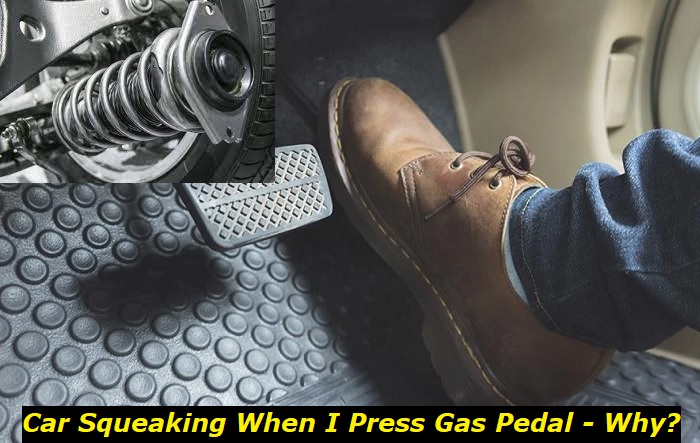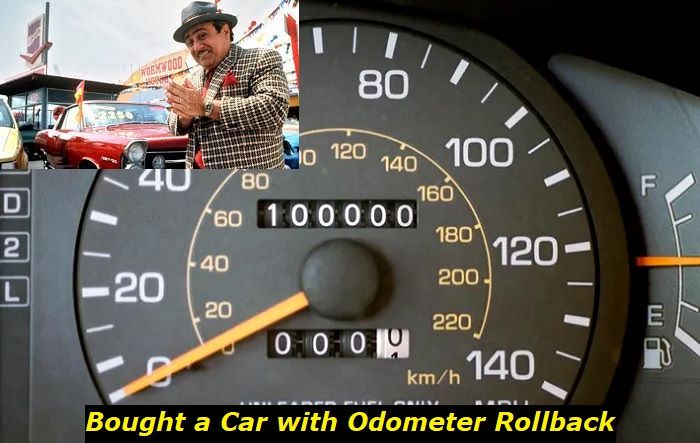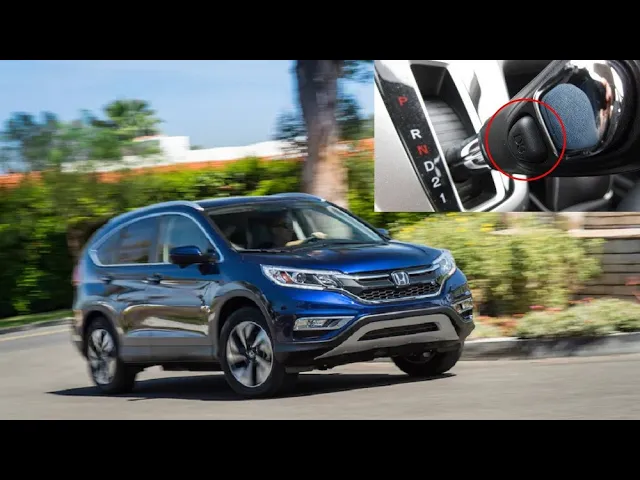Your car's gas pedal (accelerator) is positioned on the far right of the driver-side floor. It's pushed down by the driver's right foot to make the vehicle move faster. But it's prone to malfunctioning like every other moving part of a car. You may get squeaks when you depress the accelerator.
The most common reasons for hearing a squeaky noise when you push the gas pedal are faulty engine belts, worn brake pads, and poorly lubricated suspension. What you're hearing can also be referred to as screeching or squealing, depending on how it sounds to you.

There are many other causes of this sound to discover as you read further. We've also dedicated a section of this post to describing how to resolve various issues related to squeaking, screeching, or squealing when accelerating.
Why Your Car Is Producing a Squeaky Sound When Accelerating
There are various reasons for the squeaks you hear when pressing down the gas pedal. And we'll explain them in this section, including the faults mentioned in the introduction.
1) Engine Belt Wear
Engine belts help to regulate an internal combustion engine's timing by making some relevant parts operate in sync with one another. But a worn-out, loose, or damaged one can make the car squeak when using the accelerator. This is expected to happen to old, overused engine belts.
The belt could be frayed or even split. Therefore, it would be dangerous to your engine if driving continues. Doing so could lead to the engine overheating, failing, sustaining irreparable damage, etc.
2) Tensioner Wear
Tensioners help to maintain belt tightness, thereby avoiding looseness or slipping. They produce enough tension while the car is being driven. And the belts will move the pulleys which will in turn drive parts of the engine. This operation wears out tensioners after a long period of use, causing the squeaks you hear.
3) Pulley Wear
Pulleys are wheels that are linked to car engines and are utilized in the transmission of power to the belts. They're part of a system that generates power to peripheral units located in the engine bay. For example; power steering, air conditioner (AC), fan, etc.
Various pulley types work for different purposes in your car. And they can suffer wear just like engine belts and tensioners, resulting in that annoying squeaking.
4) Engine Mount Wear
The mounts of an engine support its weight and absorbs its vibrations. In other words, it holds an engine in place securely. The wearing out of this part will lead to a variety of problems-one of which is the squeaky sound. Driving your car with such a fault can in no way be comfortable or pleasant.
5) Brake Part Defects
A car's braking system is one of the most essential safety features of the vehicle. Brakes are devices that hinder the vehicle's movements when you depress the brake pedal.
So what if the brake pads, brake rotor, and other relevant parts of the system become worn out, dirty, or defective? It could be a potential factor for the production of various vehicle noises. This is including the squeaks you hear when using the brakes while increasing your driving speed.
A brake wear indicator typically makes a screeching or squealing sound when the brake pads have become too thin to be usable. That's a feature put in by manufacturers to warn vehicle owners that the pads need to be swapped out.
Brake pad wear indicators can be electrical in design. Such types feature dedicated sensors that signal to the vehicle owner when the standard wear limit is reached. Other sounds that could be heard when pushing down the brake pedals are grinding, vibrating (juddering), clattering, and rattling.
6) Poorly Lubricated Suspension Parts
A car's suspension system is engineered to ensure balance and smoothness when driving on the road. But accelerating with the suspension components inadequately lubricated can cause the system's squeakiness (creakiness).
Besides, the drive will be uncomfortable since the system isn't stable enough to withstand vibrations and shocks. This may be scary to experience the first time, but rest assured that the vehicle isn't falling apart YET. Just find a good parking spot and get the vehicle examined.
The areas that need to be lubricated include the ball joints, tie rod ends, U-joints, sway-bar links, control-arm pivots, etc. Many recent-year model vehicles feature sealed suspension joints that are referred to as "lubed for life". You can't pour lubricants into such types. But the lubricants may expire or leak, so you'll have to change the affected unit.
7) Wheel Bearing Defects
A wheel bearing is an important component of your car's wheel assembly that links the axles to the wheels. It facilitates the smooth rotation of the wheel by ensuring low friction. The types of bearings include tapered bearings (tapers) and ball bearings (steel balls). Bearings are held together by metal rings.
Dirt or wear on bearings can lead to the annoying sound you're hearing. Squeaking is produced when the parts rub against each other as you step on the gas. Other potential sounds from bearing defects are growling, howling, humming, rumbling, and chirping.
The culprit is most likely the worn seals that have been damaged by sand or dirt, chemicals, salt, and other corrosive materials. The corrosive agents will penetrate the seals and create an opening for debris to get into the bearings.
8) Damaged or Loose Exhaust System
An exhaust system receives gases from the engine's cylinders and makes the vehicle's emissions eco-friendly. It also performs the role of noise reduction. You should expect abnormal noises from this system when something goes wrong with it. For example; chugging, shuddering, rhythmic hissing, etc.
Squeaking will occur when it has sustained damage or it isn't well-arranged under the vehicle. The parts that are most likely to get displaced or damaged include the catalytic converter, sensors, exhaust manifold, cylinders, etc.
The vehicle parts mentioned in this section can produce multiple kinds of sounds depending on the faults they have. The combinations of sounds that each component can produce are similar to one another since they're all mostly mechanical faults from a moving vehicle.
What Other Noises May Be Heard When Pushing Down the Gas Pedal?
Your car may make other kinds of sounds when you accelerate at high or low speeds. And you should take any of them seriously when experienced. Below is a list of the noises as well as their meanings or possible locations of their related faults.
- Slapping - Tire damage
- Chirping - Axle issue
- Ticking - Low oil level
- Hissing - Leaking hose near the air intake
- Rattling - Exhaust system/catalytic converter or oil level issues
- Rumble - Exhaust system or leakage
- Grinding - Transmission/clutch or braking system
- Roaring - Exhaust system
What Other Situations Can Produce Squeaky Noises?
Squeaks can be heard in other scenarios, apart from when you use the gas pedal. For example; when you turn the ignition, rotate the steering wheel, ply a rough terrain, open the door/hood/trunk, etc. You may also hear it when the engine is idling. Now, see the list of potential malfunction locations below.
- Power steering system
- Air intake system
- Alternator
- Tires
- Suspension system
Fixes for the Squeaky Noise in Your Car
Most of the vehicle parts mentioned under the "reasons" section have to be repaired by replacing the bad parts. Swap them out as long as they're worn or damaged. Hire a reputable mechanic for the tedious fixes such as suspension lubrication. But you can go DIY for simple changes like brake pad swaps as described below.
DIY Brake Pad Swap Procedure:
Step 1: Buy matching replacement pads and rotors. Rotor changes are always advised.
Step 2: Let your car cool down.
Step 3: Use a lug wrench to loosen the lug nuts that hold the wheels.
Step 4: Jack the car up and remove the wheels.
Step 5: Remove the brake caliper bolts utilizing a ring spanner or socket.
Step 6: Cautiously hang the caliper to the wheel well utilizing a small piece of cable.
Step 7: Take out the old brake pads and rotors carefully.
Step 8: Install the replacement pads and rotors.
Step 9: Check the brake fluid level and top it up.
Step 10: Put the calipers and wheels back in place.
Routine Maintenance to Prevent Squeaking
A car owner can avoid squeaking in many cases by ensuring regular vehicle maintenance checks. Don't neglect any of the parts or areas mentioned in this guide. Replace worn-out parts or components that are about to expire.
You don't have to wait for the recommended mileage to replace certain items. And checking some components or areas could save other related or connected parts. For example; brake rotor damage can be prevented if the brake pads are swapped out on time.
Conclusion
You'd have to pay full attention or be nonreactive to find out when or where the noise is produced. This will help in your DIY troubleshooting procedure or explanation to the mechanic. Always remember that it's best to quickly diagnose and find a solution to abnormal car sounds before complications develop.
About the authors
The CarAraC research team is composed of seasoned auto mechanics and automotive industry professionals, including individuals with advanced degrees and certifications in their field. Our team members boast prestigious credentials, reflecting their extensive knowledge and skills. These qualifications include: IMI: Institute of the Motor Industry, ASE-Certified Master Automobile Technicians; Coventry University, Graduate of MA in Automotive Journalism; Politecnico di Torino, Italy, MS Automotive Engineering; Ss. Cyril and Methodius University in Skopje, Mechanical University in Skopje; TOC Automotive College; DHA Suffa University, Department of Mechanical Engineering






Add comment